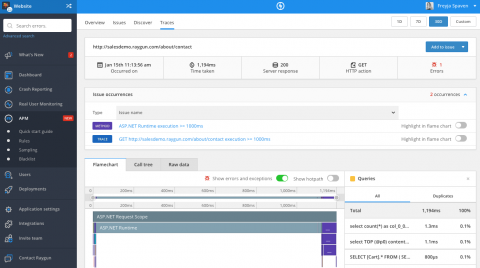Operations | Monitoring | ITSM | DevOps | Cloud
Latest Posts
Introducing granular permissions: Customize team member's access for finer control
Thousands of developers work in Raygun every day. But as the number of team members added to your organization grows, it can be tough to make sure only plan Owners have access to major plan settings in Raygun. Starting today, if you are a plan Owner, granular permissions will help you gain more control over who has access to key Raygun settings at the product, app and plan level.
Confidently ship code using Continuous Integration (CI) and Continuous Delivery (CD)
We all want to ship code on a daily basis. As developers, we want the faster feedback cycle that comes with continuous delivery, and we know it’s better for our team and product in the long run. So why do so many development teams still have such long release cycles? While long release cycles are tried and true and can be seen as more stable, teams sacrifice much more than faster feedback cycles.
Best practices for tracing and debugging microservices
Cultivating a high-performance culture in your software team
Chances are, you’ve had a difficult job with a difficult boss. In such a job, the environment isn’t just unpleasant, it’s demoralizing and depressing. The culture of such a team, or even an entire company, has an enormous impact on the health and wellness of its employees. You may not have been aware of it at the time, but your difficult boss was very likely dealing with the same situation. Difficult bosses often have even more demanding, difficult bosses.
C# Debugging tools and techniques
Working in C#, as with any language, you’ll soon find that that you need to do some debugging. With C#, thankfully, due to a plethora of debugging tools and techniques, troubleshooting is usually straightforward.
Writing High Performance .NET Code
At some point in our careers, many of us have found ourselves working on a project that requires performance tuning. The need to write high performance .NET code should come from performance issues or business needs. Today, we’ll take a look at just a few of the ways we can improve our .NET application’s performance. And hopefully, you’ll take away something that you can use on your current and future products.
Serverless error monitoring: Strategies you can use
February Launch Notes: The latest Dashboard enhancement for RUM and more
Raygun’s Launch Notes are your regular round-up of all the improvements we made to Raygun last month—from major features to performance updates.
DevOps interview questions: How to prepare
On LinkedIn, there are more than thirty thousand U.S.-based DevOps positions. That number may not be as high as it is for software developers, but it’s still higher than sysadmins or systems engineers. Maybe this demand has you interested in switching career paths, or maybe you want to change jobs. If that’s the case, you’re in luck. Today’s post will present some common interview questions that you’ll probably get when interviewing for a DevOps position.











